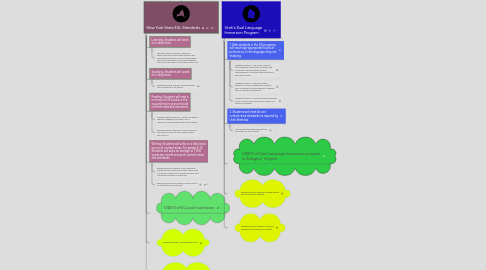
1. New York State ESL Standards
1.1. Listening: Students will listen on a daily basis
1.1.1. Teaching practice example: reading an easily-understood book to the students and using labeled pictures of objects mentioned in the book for student to see. Having students write their own version of the story or act it out.
1.2. Speaking: Students will speak on a daily basis
1.2.1. Teaching practice example: Pairing students (see comment box for details)
1.3. Reading: Students will read a minimum of 25 books or the equivalent per year across all content areas and standards.
1.3.1. Teaching practice example: Instruct students to underline, highlight, and make a list of unknown vocabulary words they read in books.
1.3.2. Teaching practice example: Acquire books for the classroom that are at an easier reading level for ELLs.
1.4. Writing: Students will write on a daily basis across all content areas. For grades 2-12: Students will write an average of 1,000 words per month across all content areas and standards.
1.4.1. Teaching practice example: After listening to the teacher read a book, have the student write a summary of the story or rewrite the story from a different character's perspective.
1.4.2. Example from Kristina Robertson from Colorin' Colorado (see comment box)
1.5. VIDEO of ELL pull-out lesson
1.6. Teaching strategy: Sheltered instruction
1.7. Teaching Strategy: work towards learner autonomy
1.7.1. Learner autonomy is achieved when an English Language Learner is motivated to learn and complete work on their own. A teacher must help students identify how they learn best and encourage them to set learning goals for themselves.
2. Utah's Dual Language Immersion Program
2.1. 1. Utah students in the DLI programs will reach age-appropriate levels of proficiency in the languages they are studying.
2.1.1. Teaching Practice 1: Use visuals, gestures, body language, expressions, modeling, and movement to help students develop comprehension. Use actual objects, pictures, and videos as well.
2.1.2. Teaching Practice 2: Ask open-ended questions. This will engage their cognitive skills. Follow up by asking students to expand upon or support their answers.
2.1.3. Teaching Practice 3: Consistently push students to use new words and expressions, and to use specific vocabulary.
2.2. 2. Students will meet all core content-area standards as required by Utah State law.
2.2.1. Coordinate with partner teacher (see comments for more details)
